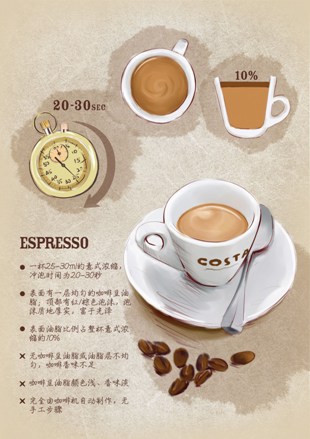COSTA's "Golden Rule of Coffee" teaches you to distinguish between quality coffee.
With more than 400 billion cups of coffee consumed worldwide each year, coffee has undoubtedly become one of the most popular drinks in the world. There are many types of coffee, styles and production methods, but the same thing is that every good cup of coffee will become a pleasant experience, while bad coffee will only ruin the good mood.

Those differences in quality can be experienced in just a sip. How do we know if a cup of coffee is good?
This article from COSTA Perfect Coffee Family will lead you to enjoy a comfortable coffee time.
Coffee beans:
Good coffee beans are a prerequisite for good coffee. COSTA uses high-quality coffee beans, and through a special method, 6 Arabica coffee beans and 1 Robusta coffee beans are perfectly mixed to create COSTA's unique coffee bean mixing method-Mocha Italia. Arabica coffee beans give coffee fruit acidity, attractive aroma, long aftertaste and other characteristics; Robusta coffee beans bring rich taste and the most important coffee oil.
Top Freshness:
Coffee is a natural plant grown seasonally. Ripe coffee cherries are green, and after roasting, they turn into brown coffee beans. To make good coffee, first, the coffee cherries used for roasting must be freshly harvested; second, each bag of coffee beans must be used as soon as possible after opening, and the coffee powder must be freshly ground.
It all depends on timing:
Espresso is the base of all other COSTA coffees and its optimal distillation time is 20-30 seconds. Too long a time will aggravate the bitterness; too short a time will cause the lack of taste, aroma, aftertaste and other layers.
Careful Handwork:
Take a closer look at the equipment used in the coffee shop. Good coffee is hand-made by the coffee quality division according to the steps, and it is definitely not something that can be achieved by a fully automatic coffee machine. The perfect espresso is controlled by experienced, dedicated baristas who ensure precise extraction. Please note the barista's dedication and focus on the job. If you can see every step of coffee making, I believe you will have a wonderful experience. A good barista can meet the different needs of customers for coffee, but the machine cannot.
Capacity:
Espresso coffee is distilled from coffee powder, the best capacity is 25-30ml, and contained in white porcelain conical cup. Too big a mouth will speed up the coffee cooling. Less distilled is more concentrated and we call it Ristretto; too much distilled is lighter and tastes more like American coffee.
Appearance:
The reddish brown foam on the surface of espresso coffee is also called coffee grease, and this layer of grease can explain the quality of coffee to a large extent. The foam of a good coffee should be thick, smooth, shiny, and full of the aroma of coffee fat. Foam color should not be too dark or too light, light color indicates that hot water and coffee powder contact speed is too fast, taste concentration is insufficient; too dark brown indicates that the speed is too slow, will aggravate the bitter taste of coffee. The fat should be thick enough to cover the underlying coffee, thick and firm, and can be pushed with a coffee spoon.
The milk used in cappuccino should be steamed and frothed, and the foam sinks to the bottom of the cup and floats to the top of the cup. Also, when you dip the coffee spoon into the bottom of the cup, you should be able to see the layered sediment formed by the espresso.
Latte comes in three layers from top to bottom: 1 cm thick foam, hot milk, and espresso poured through the milk and foam into the bottom of the cup.
The smell of success:
A truly premium Italian concentrate with an extremely attractive aroma. You can smell the sourness and sourness of fresh fruit, a slight bitterness, and sometimes a hint of spiciness and woody aromas. Old, low-quality or pre-ground coffee beans will only result in a lack of flavor in the final finished coffee.
Temperature:
Espresso brewed at 75-80 ° C; cups preheated to 35-40 ° C. Distillation temperature is too high coffee oil is burned, coffee taste bitter; temperature is too low aroma can not be fully released. Espresso should be consumed within 2 minutes of completion of distillation.
Taste:
The ultimate test, of course, is taste. Italian concentrate has intense aromas and fruity aromas, a rich taste like melted chocolate, and a long finish. Only on the basis of this quality espresso will you be able to better choose other coffee flavors you like.
Law:
In order to help consumers identify the most common coffee qualities, COSTA coffee experts have summarized a series of "coffee golden rules" for judging coffee quality. These rules are simple and practical. Just by observing the appearance, composition ratio, smell, temperature and preparation process of coffee, you can judge the quality of a cup of coffee and stay away from bad coffee:
Italian concentrate:
1 cup 25-30ml Italian concentrate, distillation time 20-30 seconds
The surface has a uniform layer of coffee bean fat; the top has red/brown foam, which is thick and shiny
10% of the whole cup of Italian concentrate, rich aroma
Every cup is freshly made on site.
Error:
Fully automated by coffee machine, no manual steps
No coffee bean fat or fat layer uneven, lack of flavor
The light color of coffee bean oil indicates that the distillation time is too short, and the coffee aroma is not completely released; the dark brown color indicates that the distillation is too bitter, or the coffee is not freshly made.
Burnt rubber smell, indicating that Robusta coffee is too heavy, resulting in too much caffeine and affecting taste
Particulate deposits at the bottom of the coffee cup indicate that the barista did not thoroughly clean the filter
Cappuccino:
Based on high quality Italian concentrate
Each cup is about 150ml, served in a shallow flaring cup.
Espresso aromas penetrate the milk and are clearly discernible.
Brown coffee bean fat, close to the milk bubble around the cup at the mouth
The milk foam is soft and fine. If it is not stirred, the foam layer can be retained to the bottom of the cup.
Error:
Milk overheated to a burnt, bitter smell
Milk too cold, too much or difficult to distinguish from latte
Latte:
Based on high quality Italian concentrate
Each cup is about 150ml, and the ratio of milk to coffee is about 3:1.
Use fresh whole milk and heat milk in metal containers
The milk foam is fine and bright, without visible bubbles; the texture is uniform and the thicker the better
Error:
The milk is over-steamed and full of bubbles.
Milk overheated, bitter and smelly
COSTA has always been committed to providing quality coffee. Since the brand was founded in 1971, its unique mocha Italian coffee bean blending method and slow roasting process have been born and continue to this day, giving COSTA a distinctive rich taste. Each coffee master in COSTA shop is carefully trained by senior coffee experts, which ensures that each cup of COSTA coffee tastes uniform, pure and authentic, and can withstand the test of "coffee golden rule".
Important Notice :
前街咖啡 FrontStreet Coffee has moved to new addredd:
FrontStreet Coffee Address: 315,Donghua East Road,GuangZhou
Tel:020 38364473
- Prev

Basic knowledge of espresso espresso
The golden rule of an ideal espresso indicates the extraction time and the amount of extraction. The golden rule is a good guideline, but in many cases, color is a better indicator of grinding thickness and whether the packing is correct or not. Although it is not absolutely necessary, the extraction process can be clearly shown by observing the extraction with a bottomless cooking handle. When using the normal cooking handle, pass carefully
- Next

Extraction of good coffee and standard coffee extraction time
After the essence of the decisive game has been properly picked, made and baked, it comes to the last two gates of import, grinding and extraction.
Related
- Detailed explanation of Jadeite planting Land in Panamanian Jadeite Manor introduction to the grading system of Jadeite competitive bidding, Red bid, Green bid and Rose Summer
- Story of Coffee planting in Brenka region of Costa Rica Stonehenge Manor anaerobic heavy honey treatment of flavor mouth
- What's on the barrel of Blue Mountain Coffee beans?
- Can American coffee also pull flowers? How to use hot American style to pull out a good-looking pattern?
- Can you make a cold extract with coffee beans? What is the right proportion for cold-extracted coffee formula?
- Indonesian PWN Gold Mandrine Coffee Origin Features Flavor How to Chong? Mandolin coffee is American.
- A brief introduction to the flavor characteristics of Brazilian yellow bourbon coffee beans
- What is the effect of different water quality on the flavor of cold-extracted coffee? What kind of water is best for brewing coffee?
- Why do you think of Rose Summer whenever you mention Panamanian coffee?
- Introduction to the characteristics of authentic blue mountain coffee bean producing areas? What is the CIB Coffee Authority in Jamaica?

